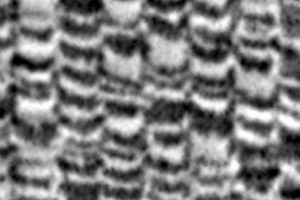 A hard drive surface as viewed using an electron microscope. Memory is stored magnetically in the pattern of dark and light patches.Image from Wikimedia Commons. / CC Attribution-Share Alike 3.0 Unported
A hard drive surface as viewed using an electron microscope. Memory is stored magnetically in the pattern of dark and light patches.Image from Wikimedia Commons. / CC Attribution-Share Alike 3.0 Unported
The Spanish filmmaker Luis Buñuel once wrote, “You have to begin to lose your memory, if only in bits and pieces, to realize that memory is what makes our lives. Life without memory is no life at all.” The same might be said (albeit with less existential fanfare) of memory in the world of computers.
In the form of bigger hard drives, computer memory has revolutionized our ability to store everything from research articles, to Hollywood films, to cookbooks. Historically these devices have been enabled through the clever manipulation of magnetism. However, recent advances at UC Berkeley and elsewhere in the development of exciting materials known as multiferroics may be changing that recipe for success.
The inside of a modern hard drive works by almost exactly the same principles that kitchen magnets exploit when holding a wedding invitation to your fridge. A material with such magnetic (or more technically, ferromagnetic) properties such as a kitchen magnet is extremely useful because of its directionality. If you place two magnets together head-to-tail they attract, whereas if you flip the top magnet and repeat the process they push each other apart. A computer essentially writes and reads information by flipping little magnetic patches up or down and measuring what happens to another magnet placed on top of them.
There is a major difference, however, between the individual size of a magnet on your hard drive and a kitchen magnet. Each computerized bit on a hard drive may be 10 billion times smaller than the size of your thumbnail in area (see the figure above). It is precisely the smallness of these details that enable a computer to remember so much information.
